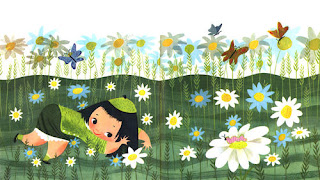Super agent
Steve Malk and one of his many amazing clients,
Carson Ellis, start out by sharing some of their favorite illustrators who weren't always illustrators. Unlike the British illustration world where many illustrators can take classes or even masters programs on children's book illustration, many American artists start out in different majors or fields.
A few of the best children's book illustrators and their original vocations:
Marc Simont, famous as an editorial illustrator
William Steig, editorial also
Bill Peet, animator
Claire Keane, animator (and generations of awesome artist in the family)
Jen Corace, amazing fine artist
Nikki McClure, amazing fine artist, waaaaaaaaay cooler than Steve
Jon Klassen, animation/film
The Provensens, animation and advertising
Carson did a lot of album art for her husband's band as well as art for galleries—art that looked a lot like children's book illustration but dirtier, as well as editorial illustration. All of which she still does, but she now considers herself squarely in the children's book illustrator role.
Steve saw one of Carson's covers for
The Decemberists, and was twitterpated. He felt like she needed to be making children's books and he didn't want anyone else representing her work but him.
 |
| Carson's art that Steve first saw and said holy frijoles about. Steve thought this screamed children's book and he loved that it reminded him of art in the tradition of Edward Gorey. |
So, what if you aren't schooled in illustration but are an oil painter or a video game artist? Here're a few of Carson and Steve's tips:
Read as many children's books as you can
Do some soul searching: How much do you love children's books? To Steve this is the most important ingredient, what works for all of the crossover artists mentioned above is their deep and abiding love for children's books. "It sounds intangible, but you really have to have it, it's what guides you through this business... We're all book nerds."
 |
| Sasek |
According to Carson if you love to draw and want to make money off of it, there are many different ways to do that in other fields, if you're getting into children's books to make money or for more creative autonomy, then you probably have a good chunk of what you need to be successful in the field, but you don't have the most important part which is love of the medium.
Be honest with yourself, it's okay to not love children's books!
Okay, you're still with us? Next thing to do is:
Work as much as you can and as hard as you can.
 |
| Richard Scarry |
Carson says: Work and work and work and compulsively draw and when you turn around and see what you've done and it's starting to look like children's book illustration, you'll know you are on the right track. Steve says: There's no excuse to not be working. Reillustrate a favorite fairy tale or kid's book cover. Getting published is a tough job and you'll be put through your paces, editors and art directors want to know you have a good work ethic.
Develop a portfolio that's specific to children's books
 |
| Tomi Ungerer |
Steve will defer to the art directors in the room, but when you're forcing an AD or editor or agent to make the leap for you, visualizing your work that does not speak to typical children's book art, you're making it that much harder on the people that want to hire you.














































.JPG)



